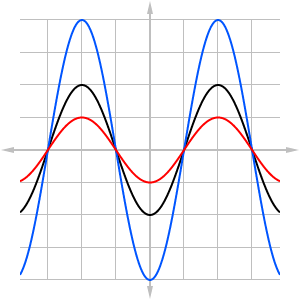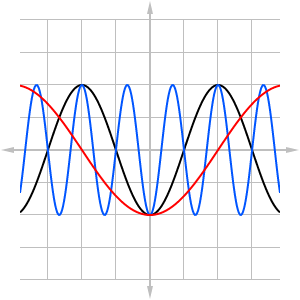Why It Matters: Algebraic Operations on Functions
 Why Study Algebraic Operations on Functions?
Why Study Algebraic Operations on Functions?
If you could “see” the sound coming from your speakers or earphones, it might resemble a series of ups and downs corresponding to the vibrations caused by the sound as it travels through the air. In fact, with the help of a tool called an oscilloscope, it is possible to visualize sounds as waves (technically, sound travels through air as a series of compression waves, however the oscilloscope converts sound to transverse waves for better visualization).
The wave itself may be regarded as the graph of a function. In other words, the sound wave may be modeled by the rule
[latex]y=f\left(x\right)[/latex]
It is not essential to understand exactly how this function is put together - you might learn more about the details of sound waves after studying a little trigonometry - however we can use what we learn in this module to transform the wave in certain ways. Figure 1
Figure 1[latex]y=a\cdot f\left(x\right)[/latex]
 Figure 2
Figure 2[latex]y=f\left(b\cdot x\right)[/latex]
In this module, you will learn all about these kinds of transformations along with other ways of changing and combining functions.Learning Outcomes
Review Topics for Success- Find the domain of a square root and rational function
- Find the domain of a function from its algebraic form.
- Define the domain of linear, quadratic, radical, and rational functions from graphs
Compositions of Functions
- Combine functions using algebraic operations.
- Create a new function by composition of functions.
- Evaluate composite functions.
- Find the domain of a composite function.
- Decompose a composite function into its component functions.
Transformations of Functions
- Graph functions using vertical and horizontal shifts.
- Graph functions using reflections about the x-axis and the y-axis.
- Determine whether a function is even, odd, or neither from its graph.
- Graph functions using compressions and stretches.
- Combine transformations.
Inverse Functions
- Verify inverse functions.
- Determine the domain and range of an inverse function, and restrict the domain of a function to make it one-to-one.
- Find or evaluate the inverse of a function.
- Use the graph of a one-to-one function to graph its inverse function on the same axes.
Licenses & Attributions
CC licensed content, Original
- Why It Matters: Algebraic Operations on Functions. Authored by: Lumen Learning. License: CC BY: Attribution.
- 3 sinusoidal waves (Figure 1). Authored by: Shaun Ault for Lumen. License: CC BY: Attribution.
- 3 sinusoidal waves (Figure 2). Authored by: Shaun Ault for Lumen. License: CC BY: Attribution.
- Revision and Adaptation. Provided by: Lumen Learning License: CC BY: Attribution.
CC licensed content, Shared previously
- Tektronix Oscilloscope. Authored by: stanhua. Located at: https://www.flickr.com/photos/stanhua/149924240. License: CC BY: Attribution.
